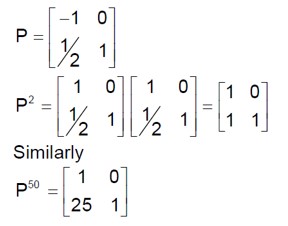Maths Matrices
Get insights from 118 questions on Maths Matrices, answered by students, alumni, and experts. You may also ask and answer any question you like about Maths Matrices
Follow Ask QuestionQuestions
Discussions
Active Users
Followers
New answer posted
3 months agoContributor-Level 10
Δ = |1,1, -1; 1,2, α 2, -1,1| = 1 (2+α)-1 (1-2α)-1 (-1-4) = 2+α+2α-1+5 = 3α+6=0 ⇒ α=-2.
Δ? = |2,1, -1; 1,2, α β, -1,1| = 2 (2+α)-1 (1-αβ)-1 (-1-2β) = 4+2α-1+αβ+1+2β = 4+2α+αβ+2β=0.
4-4-2β+2β=0. This holds.
Δ? = |1,2, -1; 1,1, α 2, β,1| = 1 (1-αβ)-2 (1-2α)-1 (β-2) = 1-αβ-2+4α-β+2 = 1+4α-αβ-β=0.
1-8+2β-β=0 ⇒ -7+β=0 ⇒ β=7.
α+β = -2+7 = 5.
New answer posted
3 months agoContributor-Level 10
A = [, [-1, 4]. |A| = 2 - 1 = 1.
Characteristic equation: λ² - tr (A)λ + |A| = 0 ⇒ λ² - 3λ + 1 = 0.
By Cayley-Hamilton, A² - 3A + I = 0. A? ¹ (A² - 3A + I) = A - 3I + A? ¹ = 0.
A? ¹ = 3I - A.
Comparing with A? ¹ = αI + βA, we get α=3, β=-1.
4 (α - β) = 4 (3 - (-1) = 16.
New answer posted
3 months agoContributor-Level 10
Given x + 2y – 3z = a
2x + 6y – 11z = b
x – 2y + 7z = c
Here
For infinite solution
20a – 8b – 4c = 0 5a = 2b + c
New answer posted
3 months agoContributor-Level 10
is symmetric. So, q = r.
Sum of diagonal elements =
Total number of matrices = 4.
New answer posted
3 months agoContributor-Level 10
all i = 1, 2, 3
Case 1 7 one's and two zeroes which can occur in 
Case 2 One 2 three 1's five zeroes =
total such matrices = 504 + 36 = 540
New answer posted
3 months agoContributor-Level 10
CT = -C. Hence C is skew symmetric metrix
Hence system have infinite solution
Taking an Exam? Selecting a College?
Get authentic answers from experts, students and alumni that you won't find anywhere else
Sign Up on ShikshaOn Shiksha, get access to
- 65k Colleges
- 1.2k Exams
- 679k Reviews
- 1800k Answers



